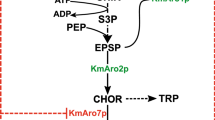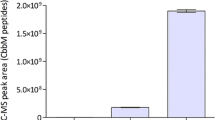Abstract
The non-conventional yeast Arxula adeninivorans was equipped with the genes phbA, phbB and phbC of the polyhydroxyalkanoate (PHA) biosynthetic pathway of Ralstonia eutropha, which encode β-ketothiolase, NADPH-linked acetoacetyl-CoA reductase and PHA synthase, respectively. Arxula strains transformed solely with the PHA synthase gene (phbC) were able to produce PHA. However, the maximum content of the polymer detected in these strains was just 0.003% poly-3-hydroxybutyrate (PHB) and 0.112% poly-3-hydroxyvalerate (PHV). The expression of all three genes (phbA, phbB, phbC) resulted in small increases in the PHA content of the transgenic Arxula cells. However, under controlled cultivation conditions with minimal medium and ethanol as the carbon source, the recombinant yeast was able to accumulate up to 2.2% PHV and 0.019% PHB. Possible reasons for these differences are discussed.




Similar content being viewed by others
References
Babel W (1997) Polyhydroxyalkansäuren—ein Kapitel Umweltprophylaxe. BioWorld 4:16–20
Babel W, Ackermann JU, Breuer U (2001) Physiology, regulation, and limits of the synthesis of poly(3HB). Adv Biochem Eng/Biotechnol 71:125–157
Bradford MM (1976) A rapid and sensitive method for the quantitation of microgram quantities of protein utilizing the principle of protein-dye binding. Anal Biochem 72:248–254
Breuer U, Ackermann JU, Babel W (1995) Accumulation of poly(3-hydroxybutyric acid) and overproduction of exopolysaccharides in a mutant of a methylotrophic bacterium. Can J Microbiol 41 [Suppl 1]: 55–59
Breuer U, Terentiev Y, Kunze G, Babel W (2002) Yeast as producers of polyhydroxyalkanoates: genetic engineering of Saccharomyces cerevisiae. Macromol Biosci 8:380–386
Davis E, Larkins BA, Knight RH (1972) Polysomes from peas. An improved method for their isolation in the absence of ribonuclease inhibitors. Plant Physiol 50:581–584
Gellissen G, Hollenberg CP (1997) Application of yeasts in gene expression studies: a comparison of Saccharomyces cerevisiae, Hansenula polymorpha and Kluyveromyces lactis. Gene 190:87–97
Gerngross TU, Snell KD, Peoples OP, Sinskey AJ, Csuhai E, Masamune S, Stubbe J (1994) Overexpression and purification of the soluble polyhydroxyalkanoate synthase from Alcaligenes eutrophus: evidence for a required posttranslational modification for catalytic activity. Biochemistry 33:9311–9320
Hanahan D (1983) Studies on transformation of Escherichia coli with plasmids. J Mol Biol 166:557–580
Kunze G, Kunze I (1994) Characterization of Arxula adeninivorans strains from different habitats. Antonie Van Leeuwenhoek 65:29–34
Leaf TA, Peterson MS, Stoup SK, Somers D, Srienc F (1996) Saccharomyces cerevisiae expressing bacterial polyhydroxybutyrate synthase produces poly-3-hydroxybutyrate. Microbiology 142:1169–1180
Nawrath C, Poirier Y, Somerville C (1994) Targeting of the polyhydroxybutyrate biosynthetic pathway to the plastids of Arabidopsis thaliana results in high levels of polymer accumulation. Proc Natl Acad Sci USA 91:12760–12764
Poirier Y, Erard N, Macdonald-Comber Petetot J (2001) Synthesis of polyhydroxyalkanoate in the peroxisome of Saccharomyces cerevisiae by using intermediates of fatty acid β-oxidation. Appl Environ Microbiol 67:5254–5260
Poirier Y, Erard N, Macdonald-Comber Petetot J (2002) Synthesis of polyhydroxyalkanoates in the peroxisome of Pichia pastoris. FEMS Microbiol Lett 207:97–102
Riis V, Mai W (1988) Gas chromatographic determination of poly-β-hydroxybutyric acid in microbial biomass after hydrochloric acid propanolysis. J Chromatogr 445:285–289
Rose MD, Winston F, Hieter P (1990) Methods in yeast genetics. A laboratory course manual. Cold Spring Harbor Laboratory Press, Cold Spring Harbor, N.Y.
Rösel H, Kunze G (1998) Integrative transformation of the dimorphic yeast Arxula adeninivorans LS3 based on hygromycin B resistance. Curr Genet 33:157–163
Sambrook J, Fritsch EF, Maniatis T (1989) Molecular cloning: a laboratory manual. Cold Spring Harbor Laboratory Press, Cold Spring Harbor, N.Y.
Samsonova IA, Kunze G, Bode R, Böttcher F (1996) A set of genetic markers for the chromosomes of the imperfect yeast Arxula adeninivorans. Yeast 12:1209–1217
Stoltenburg R, Wartmann T, Kunze I, Kunze G (1995) Reliable method to separate free and membrane-bound polysomes from different yeast species. Bio/Techniques 18:564–568
Tanaka A, Ohnishi N, Fukui S (1967) Studies on the formation of vitamins and their function in hydrocarbon fermentation. Production of vitamin B6by Candida albicans in hydrocarbon medium. J Ferment Technol 45:617–623
Valentin HE, Steinbüchel A (1993) Application of enzymatically synthesized short-chain-length hydroxy fatty acid coenzyme A thioesters for assay of polyhydroxyalkanoic acid synthases. Appl Microbiol Biotechnol 40:699–709
Wartmann T, Kunze G (2000) Genetic transformation and biotechnological application of the yeast Arxula adeninivorans. Appl Microbiol Biotechnol 54:619–624
Wartmann T, Erdmann J, Kunze I, Kunze G (2000) Morphology-related effects on gene expression and protein accumulation of the yeast Arxula adeninivorans LS3. Arch Microbiol 173:253–261
Wartmann T, Böer E, Huarto-Pico A, Sieber H, Bartelsen O, Gellissen G, Kunze G (2002) High-level production and secretion of recombinant proteins by the dimorphic yeast Arxula adeninivorans. FEMS Yeast Res 2:363–369
Wartmann T, Stoltenburg R, Böer E, Sieber H, Bartelsen O, Gellissen G, Kunze G (2003a) The ALEU2 gene—a new component for an Arxula adeninivorans-based expression platform. FEMS Yeast Res 3:223–232
Wartmann T, Bellebna C, Böer E, Gellissen G, Kunze G (2003b) The constitutive AHSB4-promoter—a novel component of the Arxula adeninivorans based expression platform. Appl Microbiol Biotechnol 62:528–535
Acknowledgements
We are grateful to A. Steinbüchel for kindly providing the PHB synthesis genes of R. eutropha. We would also like to thank H. Bohlmann, E. Häusler and I. Schmeling for their excellent technical assistance. This research work was supported by the Deutsche Bundesstiftung Umwelt (AZ 13048) and by funds from Chemical Industry (G.K.).
Author information
Authors and Affiliations
Corresponding author
Rights and permissions
About this article
Cite this article
Terentiev, Y., Breuer, U., Babel, W. et al. Non-conventional yeasts as producers of polyhydroxyalkanoates—genetic engineering of Arxula adeninivorans . Appl Microbiol Biotechnol 64, 376–381 (2004). https://doi.org/10.1007/s00253-003-1498-x
Received:
Revised:
Published:
Issue Date:
DOI: https://doi.org/10.1007/s00253-003-1498-x




